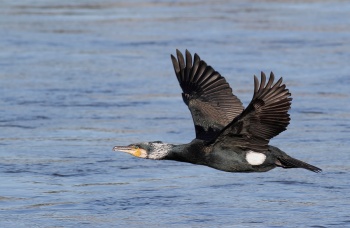
Photo © by Alok Tewari
Keoladeo National Park, Bharatpur, India, January-2017
Alternative Name: Black Cormorant
Includes: Australian Great Cormorant, White-breasted Cormorant
- Phalacrocorax carbo
Identification
80–100 cm (31½-39½ in)
- overall plumage blackish
- throat white
- gape yellow
- thigh patch white in breeding plumage
- head and neck variably white in breeding plumage (subspecies dependent)
Juvenile whitish underparts
Similar Species
Forehead less steep than European Shag. Juvenile/immature Shags both have a white throat. Cormorant always have dark feet and young Shags have paler feet (webs between the toes).
Distribution
Almost worldwide; absent from Antarctica, South America and much of North America. In North America found north of Nova Scotia in breeding season.
Winters south to Florida along the coast. Also winters in small numbers in Lake Ontario.
Taxonomy
Some authorities consider the African subspecies to be a separate species "White-breasted Cormorant", P. lucidus (Lepage, 2007) [2].
Subspecies novaehollandiae may be split as "Australian Great Cormorant", P. novaehollandiae as its nupial plumage differs [6]
Subspecies
Clements recognises the following subspecies [1]:
- P. c. carbo: Northern Europe and northern North America; winters to Gulf coast, north-western Africa
- P. c. novaehollandiae: "Australian Great Cormorant". Australia, Tasmania, New Zealand and Chatham Islands
- P. c. sinensis: North-central Europe to southern China; winters to south-eastern Asia and Indonesia
- P. c. hanedae: Honshu Island (Japan)
- P. c. maroccanus: "White-breasted Cormorant". Coastal north-western Africa (Morocco to Mauritania)
- P. c. lucidus: "White-breasted Cormorant". Africa south of the Sahara and Cape Verde Islands
Habitat
Open water and rocky coastline. Breeds on sea cliffs and on inland trees. .
Behaviour
Often seen perched on rocks, bouys and posts with their wings outspread. Swims low in the water with head raised
Diet
Their diet consists mostly of fish; crustaceans and amphibians are also eaten.
Flight
Flies higher over the water than Shags; flocks forming long lines or V-shapes.
Vocalisation
Gallery
Click images to see larger version
Nominate subspecies
Photo © by Paul Wheeler
Stover, Devon, February-2011Subspecies P c. sinensis, juvenile
Photo © by Alok Tewari
Keoladeo National Park, India, Dec-2015Subspecies lucidus, White-breasted Cormorant
Photo © by bievreJJ
Strandfontein Sewage Works, Cape province, South Africa, 13 October 2009
References
- Clements, J. F., T. S. Schulenberg, M. J. Iliff, S. M. Billerman, T. A. Fredericks, B. L. Sullivan, and C. L. Wood. 2019. The eBird/Clements Checklist of Birds of the World: v2019. Downloaded from http://www.birds.cornell.edu/clementschecklist/download/
- Lepage D. (2020) Avibase. Retrieved 21 September 2020
- Birdwatchers Pocket Guide ISBN 1-85732-804-3
- Hatch, J. J., K. M. Brown, G. G. Hogan, R. D. Morris, J. Orta, E. F. J. Garcia, F. Jutglar, G. M. Kirwan, and P. F. D. Boesman (2020). Great Cormorant (Phalacrocorax carbo), version 1.0. In Birds of the World (S. M. Billerman, Editor). Cornell Lab of Ornithology, Ithaca, NY, USA. https://doi.org/10.2173/bow.grecor.01
- Bird Forum Member Observations
- Eaton, JA, B van Balen, NW Brickle, FE Rheindt 2021. Birds of the Indonesian Archipelago (Greater Sundas and Wallacea), Second Edition. Lynx Editions. ISBN978-84-16728-44-2
Recommended Citation
- BirdForum Opus contributors. (2025) Great Cormorant. In: BirdForum, the forum for wild birds and birding. Retrieved 31 March 2025 from https://www.birdforum.net/opus/Great_Cormorant
External Links
GSearch checked for 2020 platform.1









